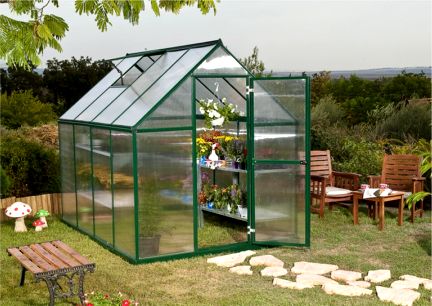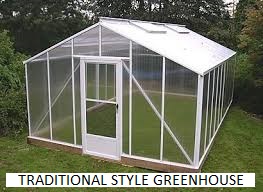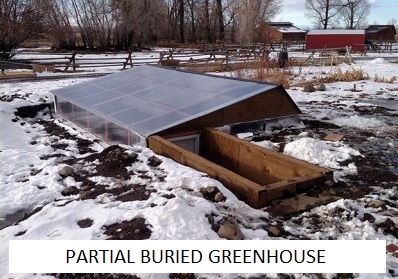blog - greenhouse design
Greenhouse Design Options
 A greenhouse can be a valuable tool for extending the ability to grow food beyond the typical season and/or for producing crops that commonly grow only in warmer climates. Given that a greenhouse can be a significant investment of time and resources, choosing a style and materials that will provide the most return on your investment is worth the small amount of research that it takes to consider the options and to choose the one that will best fit your specific location and budget.
A greenhouse can be a valuable tool for extending the ability to grow food beyond the typical season and/or for producing crops that commonly grow only in warmer climates. Given that a greenhouse can be a significant investment of time and resources, choosing a style and materials that will provide the most return on your investment is worth the small amount of research that it takes to consider the options and to choose the one that will best fit your specific location and budget.
Among the many styles of greenhouses that can be constructed, I am going to offer my thoughts on the most commonly used style, being the traditional greenhouse, and improvements that can be made to it. Then I will share what I consider to be the most useful greenhouse design, which is the partial buried style. While they can be a lower cost option, I am not going to review hoop houses (also known as high tunnels) due to the combination of their lower efficiency and reliance on less durable shorter lifespan polyethylene films (sheet plastic) as a roof covering. From a preparedness perspective, you would need to keep what I would consider an impractical amount of polyethylene film on hand for numerous repairs and replacements of the roof covering.
As a clarifying point, I am going to be evaluating greenhouse options from the perspective of someone who lives in a climate that commonly experiences winter daytime temperatures below freezing and nighttime temperatures that are well below freezing. I will be focusing on these climates since those who live in more temperate climates face far less challenges with greenhouse design considerations, other than good ventilation and exhaust capabilities. After determining the size of greenhouse that you need for supporting your food production, you will want to carefully consider what style of greenhouse will best fit your location and offer the most return on investment.
 The traditional greenhouse is likely the style that is most widely used throughout the country. Traditional style greenhouses, which commonly are built with glazing (the transparent material that lets light through) on all four walls and the roof, are among the least energy efficient. This is because the roof angle is not typically optimized for the sun angle and the glazing on the north side of the structure allows for significant heat loss without offering any appreciable solar gain (beneficial energy from the sun). This style of greenhouse can be among the most simple to purchase pre-manufactured, sold as kits, constructed as a do-it-yourself project, and are easily situated on a level site or added onto an existing house or outbuilding, such as a barn.
The traditional greenhouse is likely the style that is most widely used throughout the country. Traditional style greenhouses, which commonly are built with glazing (the transparent material that lets light through) on all four walls and the roof, are among the least energy efficient. This is because the roof angle is not typically optimized for the sun angle and the glazing on the north side of the structure allows for significant heat loss without offering any appreciable solar gain (beneficial energy from the sun). This style of greenhouse can be among the most simple to purchase pre-manufactured, sold as kits, constructed as a do-it-yourself project, and are easily situated on a level site or added onto an existing house or outbuilding, such as a barn.
 A traditional greenhouse design can be modified to significantly improve its performance by elongating the southern roof face using a saltbox style roof instead of a traditional gable style roof, setting the south facing roof angle to an optimal slope for the winter sun angle (based on the latitude of your location), and replacing the glazing on the north side of the structure with insulated materials and/or thermal mass (such as concrete, stone or other masonry). Elongating the southern roof face increases the surface area of glazing to maximize the potential for sunlight to enter the greenhouse. Adjusting the roof angle to be perpendicular to the average winter sun angle improves the amount of sunlight that can pass through the roof material when it’s needed in the coldest months of winter, while causing less of the sunlight to pass through when it is not wanted during the hot summer months. Replacing the typical glazing materials found on the north side roof and wall with materials that have good insulating properties will help to reduce unwanted heat loss during the night and over the winter. Dense masonry materials can even be added on the interior of these north facing surfaces to absorb sunlight during the day, storing it as heat energy, which is then released throughout the colder nighttime hours to help maintain the temperature of the space. Methods for providing supplemental heat in your greenhouse during the overcast days and cold nights of the winter months is another important consideration that I will address in a future article. As an additional improvement to the traditional greenhouse style, masonry knee walls can help with avoiding damage to low glazing areas, act as a passive solar heat sink, and offer ballistic protection (allowing the greenhouse to double as a fighting position).
A traditional greenhouse design can be modified to significantly improve its performance by elongating the southern roof face using a saltbox style roof instead of a traditional gable style roof, setting the south facing roof angle to an optimal slope for the winter sun angle (based on the latitude of your location), and replacing the glazing on the north side of the structure with insulated materials and/or thermal mass (such as concrete, stone or other masonry). Elongating the southern roof face increases the surface area of glazing to maximize the potential for sunlight to enter the greenhouse. Adjusting the roof angle to be perpendicular to the average winter sun angle improves the amount of sunlight that can pass through the roof material when it’s needed in the coldest months of winter, while causing less of the sunlight to pass through when it is not wanted during the hot summer months. Replacing the typical glazing materials found on the north side roof and wall with materials that have good insulating properties will help to reduce unwanted heat loss during the night and over the winter. Dense masonry materials can even be added on the interior of these north facing surfaces to absorb sunlight during the day, storing it as heat energy, which is then released throughout the colder nighttime hours to help maintain the temperature of the space. Methods for providing supplemental heat in your greenhouse during the overcast days and cold nights of the winter months is another important consideration that I will address in a future article. As an additional improvement to the traditional greenhouse style, masonry knee walls can help with avoiding damage to low glazing areas, act as a passive solar heat sink, and offer ballistic protection (allowing the greenhouse to double as a fighting position).
 The greenhouse that I recommend for most situations is the partially buried style, which is also known as a pit greenhouse or walipini. By placing part, or even a majority of the greenhouse below ground (just not the roof), you can significantly reduce the heat loss that commonly occurs through the walls. In general, the more of the greenhouse walls that you can bury the better. The depth at which you bury the greenhouse is typically dictated by the ability to access the structure (using steps or a ramp), soil types, groundwater conditions, and how all of these factors impact your budget. A south facing slope is an ideal location to place a partially buried greenhouse, since it requires less excavation and can make the access down into the greenhouse easier. The walls can be built from a wide variety of materials, including rammed earth, earth bags, stone, concrete and wood. The key to building the walls is to select a method that will properly stabilize the soil that has been exposed from the excavation process. Maintaining the structural integrity of the walls and providing proper drainage will dictate which materials and methods of construction can be used. The roof is commonly shed style (which is a single slope), set at a pitch that is optimized for the winter sun angle of the greenhouse location’s latitude. By properly combining these methods and materials, a highly efficient greenhouse can be achieved.
The greenhouse that I recommend for most situations is the partially buried style, which is also known as a pit greenhouse or walipini. By placing part, or even a majority of the greenhouse below ground (just not the roof), you can significantly reduce the heat loss that commonly occurs through the walls. In general, the more of the greenhouse walls that you can bury the better. The depth at which you bury the greenhouse is typically dictated by the ability to access the structure (using steps or a ramp), soil types, groundwater conditions, and how all of these factors impact your budget. A south facing slope is an ideal location to place a partially buried greenhouse, since it requires less excavation and can make the access down into the greenhouse easier. The walls can be built from a wide variety of materials, including rammed earth, earth bags, stone, concrete and wood. The key to building the walls is to select a method that will properly stabilize the soil that has been exposed from the excavation process. Maintaining the structural integrity of the walls and providing proper drainage will dictate which materials and methods of construction can be used. The roof is commonly shed style (which is a single slope), set at a pitch that is optimized for the winter sun angle of the greenhouse location’s latitude. By properly combining these methods and materials, a highly efficient greenhouse can be achieved.
In my next article, I will address some of the variety of construction material choices that are available for the glazing (the transparent material that lets light through) on your greenhouse. Since the glazing can be one of the most expensive components of your greenhouse, choosing the best fit for your application and budget is an important decision.
Helping you achieve a life of liberty.

© 2023 Strategic Landscape Design
